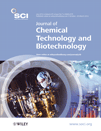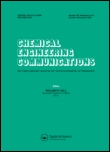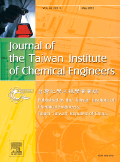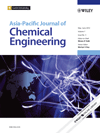
CHEMICAL ENGINEERING & TECHNOLOGY
Scope & Guideline
Innovating Solutions for Tomorrow's Challenges
Introduction
Aims and Scopes
- Chemical Process Engineering:
The journal covers various aspects of chemical process engineering, including design, optimization, and control of chemical processes. It emphasizes innovative methodologies and technologies to improve efficiency and sustainability. - Materials Science and Engineering:
Research on materials, particularly those relevant to chemical engineering applications, such as catalysts, membranes, and nanomaterials, is a core focus. The journal highlights the development and characterization of new materials. - Energy Systems and Sustainability:
The journal addresses energy production and conversion technologies, including renewable energy sources and energy-efficient processes. It promotes research aimed at sustainability and reducing the environmental impact of chemical processes. - Environmental Engineering and Waste Management:
This scope includes studies on pollution control, waste treatment technologies, and sustainable practices in chemical engineering to minimize environmental impacts. - Computational Methods and Modeling:
The use of computational tools, such as computational fluid dynamics (CFD) and machine learning, for modeling and simulating chemical processes is a significant part of the journal's focus, aiding in the understanding and optimization of complex systems. - Biochemical Engineering:
Research in biochemical processes, including biofuels, bioremediation, and fermentation technologies, is included, reflecting the integration of biological principles in chemical engineering.
Trending and Emerging
- Sustainable Chemical Processes:
There is a growing emphasis on sustainability in chemical processes, including green chemistry, waste valorization, and resource recovery, reflecting an industry-wide shift towards environmentally friendly practices. - Advanced Materials for Energy Applications:
Research into advanced materials, particularly for energy storage and conversion applications (such as batteries and fuel cells), is increasingly prevalent, driven by the demand for efficient and sustainable energy solutions. - Carbon Capture and Utilization Technologies:
Emerging technologies for carbon capture and utilization (CCU) are gaining attention, focusing on innovative approaches to mitigate climate change by converting CO2 into valuable products. - Digitalization and Industry 4.0:
The integration of digital technologies, including machine learning, the Internet of Things (IoT), and big data analytics, in chemical engineering processes is a rapidly growing area, aimed at optimizing operations and enhancing decision-making. - Biotechnology and Bioengineering:
Research in biotechnology, particularly in the context of biofuels, bioprocessing, and bioremediation, is becoming increasingly important, reflecting a broader trend towards biological solutions in chemical engineering. - Nanotechnology in Chemical Engineering:
The application of nanotechnology in various chemical engineering fields, including catalysis, material science, and environmental engineering, is on the rise, driven by the unique properties and functionalities of nanomaterials.
Declining or Waning
- Traditional Chemical Engineering Processes:
There appears to be a decline in papers focusing on conventional chemical engineering processes without innovative modifications or sustainability considerations. This reflects a trend towards more advanced, integrated approaches. - Single-Use Technologies:
The interest in single-use technologies, which gained traction in earlier years, is waning as the industry shifts focus to more sustainable and reusable systems. - Basic Reaction Kinetics Studies:
There is a noticeable decrease in the publication of studies solely focused on basic reaction kinetics without a practical application or integration into larger systems, as the field moves towards applied research with direct industrial implications. - Conventional Wastewater Treatment Methods:
Research on traditional wastewater treatment processes is declining in favor of innovative and integrated approaches, such as advanced oxidation processes and bioremediation, which are more aligned with current sustainability goals.
Similar Journals

Results in Engineering
Transforming Challenges into Breakthroughs in EngineeringResults in Engineering is an esteemed open-access journal published by Elsevier, dedicated to advancing the field of engineering through high-quality, innovative research. Since its inception in 2019, this journal has rapidly established itself within the academic community, evidenced by its prestigious Q1 ranking in the Engineering (miscellaneous) category for 2023 and a remarkable ranking of #54 out of 307 in General Engineering according to the Scopus database, placing it in the 82nd percentile of its category. Located in the Netherlands, Results in Engineering provides a global platform for researchers, professionals, and students to disseminate their findings and foster collaboration across diverse engineering disciplines. The journal's commitment to open access ensures that valuable research is accessible to a wider audience, fostering innovation and knowledge sharing. With a progressive approach to publication, Results in Engineering seeks to enhance the engineering landscape by publishing cutting-edge studies that address contemporary challenges and solutions in the field.

Engineering Review
Advancing interdisciplinary engineering research.Engineering Review is a prominent academic journal published by the University of Rijeka, Faculty of Engineering in Croatia. As an emerging outlet in the field of engineering, the journal has been providing a platform for interdisciplinary research since its inception in 2011, with a commitment to disseminating high-quality studies up to the horizon of 2024. Although currently categorized as Q4 in the Engineering (miscellaneous) section and ranking 242 out of 307 in General Engineering per Scopus metrics, the journal aims to bolster its impact and reach within the engineering community. With a focus on innovative approaches and practical applications in various engineering disciplines, Engineering Review invites contributions from researchers, professionals, and students alike, fostering a collaborative environment for the advancement of engineering research in a global context. While it is not an open-access journal at this time, it remains a vital resource for those engaged in cutting-edge engineering endeavors.

ChemEngineering
Connecting Researchers to Drive Chemical Engineering ForwardChemEngineering is a prominent open-access journal published by MDPI that has been dedicated to the dissemination of high-quality research in the field of chemical engineering since its inception in 2017. Operating out of Switzerland, this journal addresses a diverse range of topics, including energy production, process optimization, and innovations in materials science, thereby attracting contributions from researchers and professionals worldwide. With an impressive Q2 ranking in Chemical Engineering and Engineering, as well as a Q3 ranking in Energy for 2023, ChemEngineering is positioned as a crucial platform for advancing knowledge in its fields. The journal's commitment to open access ensures that its content is readily available to a broad audience, promoting the free exchange of ideas and fostering collaborations. Researchers, professionals, and students alike benefit from the journal's focus on cutting-edge research, making it an essential resource for anyone interested in the ever-evolving landscape of chemical engineering.

PROCESS SAFETY AND ENVIRONMENTAL PROTECTION
Advancing safety and sustainability in chemical engineering.PROCESS SAFETY AND ENVIRONMENTAL PROTECTION, published by Elsevier, is a premier academic journal dedicated to advancing the fields of chemical engineering, environmental science, and safety management. With an impressive impact factor, this esteemed journal undergoes a meticulous peer-review process and serves as a vital platform for researchers, professionals, and students seeking to disseminate cutting-edge research and innovative practices. Submissions are welcome in a wide scope of topics related to safety, risk, reliability, and environmental engineering, demonstrating its influence as a Q1 journal across multiple categories, including Environmental Chemistry and Safety, Risk, Reliability and Quality. By providing a rigorous analysis of current challenges and solutions in the domain since its inception in 1990, it continues to foster interdisciplinary collaboration and practical applications in the United Kingdom and beyond. With the journal not currently offering Open Access options, subscribers gain exclusive access to pivotal insights that shape industry standards and drive advancements in sustainable practices.

JOURNAL OF CHEMICAL TECHNOLOGY AND BIOTECHNOLOGY
Innovating Sustainable Solutions for Tomorrow's ChallengesJOURNAL OF CHEMICAL TECHNOLOGY AND BIOTECHNOLOGY, published by WILEY in the United Kingdom, serves as a premier platform for research at the interface of chemical engineering and biotechnology. With an ISSN of 0268-2575 and E-ISSN 1097-4660, this journal has established itself as a crucial resource for scholars and professionals, evidenced by its impactful categorization in the Q1 and Q2 quartiles across multiple domains such as Inorganic Chemistry, Biotechnology, and Renewable Energy. The journal encompasses a broad scope that includes innovative research on sustainable technologies, pollution management, and advances in chemical syntheses, making it essential for those pursuing cutting-edge developments in these disciplines. Researchers and practitioners benefit from its comprehensive coverage, as it includes insightful articles, reviews, and case studies that collectively push the boundaries of contemporary science and engineering. With a ranking of Q2 in its various categories and significant percentiles in key fields, the journal stands as a beacon for high-quality scholarship, eligible for impact in both academia and industry.

Applied Chemistry for Engineering
Bridging Theory and Practice in Chemical EngineeringApplied Chemistry for Engineering, published by the Korean Society of Industrial and Engineering Chemistry, is a vital resource for researchers and professionals engaged in the realms of chemical engineering and applied chemistry. With an ISSN of 1225-0112 and an E-ISSN of 1228-4505, this journal serves as a platform for innovative research that spans diverse applications within these fields. Although currently not classified under open access, it provides critical insights and advancements to its audience, contributing to the ongoing discourse in the industry. The journal's significance is underscored by its rankings in Scopus, where it resides in the Q4 category for both Chemical Engineering and Chemistry, evidencing its commitment to publishing relevant studies despite its emerging status. As it continues to grow through the converged years from 2007 to 2024, Applied Chemistry for Engineering aims to bridge the gap between theoretical research and practical engineering solutions, making it an essential tool for students, researchers, and professionals alike.

CHEMICAL ENGINEERING COMMUNICATIONS
Advancing the Frontiers of Chemical Science.Chemical Engineering Communications, published by Taylor & Francis Inc, is a distinguished journal within the realms of Chemical Engineering and Chemistry. With an ISSN of 0098-6445, this journal plays a pivotal role in disseminating innovative research, critical reviews, and insightful discussions that encompass a broad spectrum of topics in these fields. The journal boasts a commendable Q2 ranking in the 2023 category of chemical engineering and general chemistry, reflecting its significant contribution to the scientific community. Operating under a rigorous peer-review process, the journal attracts high-quality submissions from global researchers. Although currently not an Open Access journal, it provides extensive archive access for users interested in exploring past advancements from its inception in 1973 through to 2024. With a commitment to advancing knowledge and fostering collaboration among academia and industry, Chemical Engineering Communications remains an essential resource for professionals and students aiming to stay abreast of the latest developments in chemical sciences.

Journal of the Taiwan Institute of Chemical Engineers
Elevating knowledge exchange in the chemical sciences.The Journal of the Taiwan Institute of Chemical Engineers is a prestigious publication in the field of chemical engineering and chemistry, published by Elsevier. With an impressive impact factor placing it in the top quartiles (Q1) of both the Chemical Engineering (miscellaneous) and Chemistry (miscellaneous) categories, this journal serves as a vital platform for disseminating cutting-edge research and innovative findings. Since its inception in 2009 and continuing through 2024, it has established a strong reputation with notable Scopus rankings—ranked 40th out of 273 in General Chemical Engineering and 62nd out of 408 in General Chemistry, reflecting the journal’s significance in its field. By offering open access options, the journal ensures that research is readily available to a global audience, fostering collaboration and knowledge exchange among researchers, professionals, and students. The Journal of the Taiwan Institute of Chemical Engineers is dedicated to advancing the discipline of chemical engineering and supporting the development of novel scientific methodologies and applications.

Asia-Pacific Journal of Chemical Engineering
Advancing Knowledge at the Intersection of Chemistry and Sustainability.The Asia-Pacific Journal of Chemical Engineering, published by WILEY, serves as a vital forum for the dissemination of innovative research in the interdisciplinary domains of chemical engineering, renewable energy, sustainability, and waste management. Established in 2006, this esteemed journal has achieved a notable impact factor that reflects its commitment to advancing knowledge and practices within the chemical engineering community. With its Q3 category rankings across various fields, including Chemical Engineering (Miscellaneous), Renewable Energy, Sustainability and the Environment, and Waste Management and Disposal, the journal holds a significant position among its peers, assuring readers of quality and relevance in published content. Although it does not offer Open Access options, the Asia-Pacific Journal of Chemical Engineering remains an essential resource for researchers, professionals, and students aiming to stay at the forefront of innovations affecting the Asia-Pacific region and beyond. The journal's broad scope covers diverse topics, making it an integral part of the academic landscape from 2006 to 2024.

KOREAN JOURNAL OF CHEMICAL ENGINEERING
Connecting Ideas, Inspiring Solutions in Chemical Engineering.The Korean Journal of Chemical Engineering is a prestigious publication by the Korean Institute of Chemical Engineers, dedicated to advancing the field of chemical engineering and its associated sciences. Established in 1984, this journal has made significant contributions to the dissemination of innovative research, covering a broad spectrum of topics within chemical engineering and general chemistry. With a current impact factor placing it in the Q2 quartile within both the chemical engineering and chemistry categories, it is recognized for its rigorous peer-review process and high-quality articles. The journal provides a valuable platform for researchers, professionals, and students to share their findings and collaborate on emerging methodologies and technologies. Although it does not offer open access options, its broad international readership, bolstered by its Scopus rankings — including a commendable #108 in general chemical engineering — ensures widespread visibility and dissemination of published works. As it approaches its 40th anniversary in 2024, the Korean Journal of Chemical Engineering continues to be an essential resource for anyone engaged in the field, driving innovation and academic dialogue worldwide.